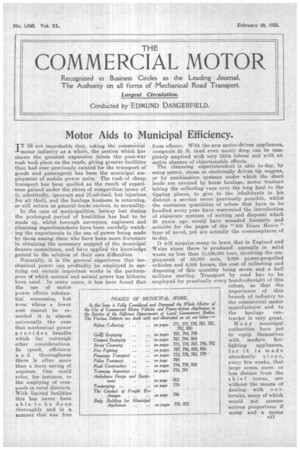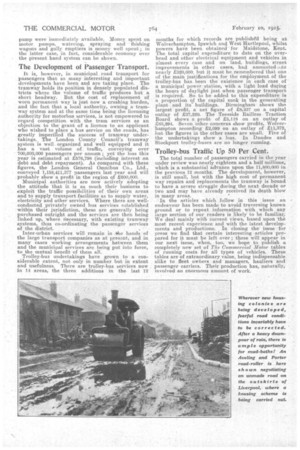Motor Aids to Municipal Efficiency.
Page 1

Page 2

If you've noticed an error in this article please click here to report it so we can fix it.
T T IS not improbable that, taking the commercial -I-motor industry as a whole, the section which has shown the greatest expansion (since the post-war rush took place on the roads, giving greater facilities than had ever previously existed for the transport of goods and passengers) has been the municipal employment of mobile power units. The rush of cheap transport has been quelled as the result of experience gained under the stress of competition (some of it, admittedly, ignorant and ill-advised, but injurious for all that), and the haulage business is returning, or will return as general trade revives, to normality.
In the case of municipalities, leeway lost during the prolonged period of hostilities has had to be made up, whilst borough surveyors, engineers and cleansing superintendents have been carefully watching the experiments in the use of power being made by these among them who have been more fortunate in obtaining the necessary support of the municipal finance committees, and have applied the knowledge gained to the solution of their awn difficulties.
Naturally, it is the general experience that mechanical power can profitably be employed in carrying out certain important works in the performance of which manual and animal power has hitherto been used. In many cases, it has been found that the use of motor power effects substantial economies, but even where a lower cost cannot be recorded it is almost universally. the case that mechanical power provides benefits which far outweigh other considerations. Th epeed, efficiency a n d thoroughness there is often more than a mere saving of expense. One could refer, for instance, to the emptying of cesspools in rural districts. With limited facilities this has never been able to be done thoroughly and in a manner that was free from offence. With the new motor-driven appliances, cesspools 25 ft. (and even more) deep can be completely emptied with very little labour and with an entire absence of objectionable effects. The cleansing superintendent is able to-day, by using petrol, steam or electrically driven tip wagons, or by combination systems under which the short leads are covered by horse haulage, motor tractors taking the collecting vans over the long haul to the tipping places, to give to the inhabitants in his district a service never previously possible, whilst the enormous quantities of refuse that have to be handled every year have warranted the introduction of elaborate systems of sorting and disposal which 20 years ago would have sounded fantastic and suitable for the pages of the " 300 Years Hence type of novel, yet are actually the commonplaces of to-day. It will surprise many to learn that in England and Wales alone there is produced annually in solid waste no less than 11,000,000 tons, involving the employment of 34,000 men, 2,000 power-propelled vehicles and 8,000 horses, the cost of collecting and disposing of this quantity being seven and a half millions sterling. Transport by road has to be employed for practically every hundredweight of this
refuse, so that the
importance of this branch of industry to the commercial motor manufacturer and to the haulage contrac-4or is very great.
Many municipal authorities have yet to equip themselves with modern firefighting appliances, for it is made abundantly eI ea r, every few weeks, that large areas, more or less distant from the chief towns, are without the means of dealing with o a tbreaks, many of which would not assume serious proportions if water and a motor pump were immediately available. Volley spent on motor pumps, watering, spraying and thishing wagons and gully emptiers is money well spent ;in the latter case, in fact, considerable economy over the Present hand system can be shown.
The Development of Passenger Transport.
It is, however, in municipal. road transport for passengers that so many interesting and important developments have been. and are taking place. The tramway holds its position in densely populated districts where the volume of traffic produces but a short headway. But the cost of replacement of worn permanent way is just now a crushing burden, and the fact that a local authority, owning a tramway system and at the same time being the licensing authority for motorbus services, is not empowered to regard competition with the tram sekvices as an objention to the grant of a licence to an applicant who wished to place a bus service on the roads, has greatly imperilled the success of tramway undertakings. The London County Council's tramway system is well organized and well equipped and it has a vast volume of traffic, conveying over 700,000,000 passengers per annum ; yet the loss this year is estimated at £570,798 (including interest on debt and debt repayment). As compared with these figures, the London General Omnibus Co., Ltd., conveyed 1,158,411,377 passengers last year and will probably show a profit in the region of £600,000. Municipal authorities are now actively adopting the attitude that it is as much their business to exploit the traffic possibilities of their own areas and te supply transport facilities as to supply water, electricity and other services. Where there are wellconducted privately owned bus services established within their jurisdiction, these are generally being purchased outright and the services are then being linked up, where necessary, With existing tramway, systems, thus co-ordinating the passenger services of the district.
Inter-urban services will remain in bile bands of the large transport companies as at present, and in many cases working arrangements between them and the municipal services are being put into force, to the mutual benefit of them all.
Trolley-bus undertakings have grown. to a considerable extent, not only in number but in extent and usefulness. There are trolley-bus services now in 14 areas, the three additions in the last 12 months for which records are publish6"d being at Wolverhampton, Ipswich and West Hartlepool, whilst powers have been obtained for Maidstone, Kent. The total capital expenditure to date on the overhead and other electrical equipment and vehicles in. almost every case and on land, buildings, street improvements in other cases, had amounted to nearly 1320,000. but it must be remembered that one of the main justifications for the employment of the trolley-bus has been the existence in each case of a municipal power, station, with a light load during the hours of daylight just when passenger transport is required. So to be added to this expenditure is a proportion of the capital sunk in the generating plant and its buildings. Birmingham shows the largest profit, a net figure of £8437 on a capital outlay of £37,220. The Teesside Railless Traction. Board shows a profit of ko,118 on an. outlay of 83,294. Seven other concerns show profits, Wolverhampton recording £2,099 on an outlay of £11,372, but the figuresin the other cases are small. Five of the undertakings show a loss. In Dundee and Stockport trolley-buses are no longer running.
Trolley-bus Traffic Up 50 Per Cent.
The total number of passengers carried in the•year under review was nearly eighteen and a half millions, which is a substantial advance upon the 11,800,000 in the previous 12 months. The development, however, is still small, but with the high cost of permanent way repairs and replacements the tramway is bound to have a severe struggle during the next decade or two and may have already received its death blow in many areas. In. the articles which follow in this issue an endeavour has been made to avoid traversing known ground or to repeat information with which any large section of our readers is likely to he familiar. We deal mainly with current views, based upon the most recent experience and with the latest developments and productions. In closing the issue for press we find that certain interesting articles prepared for it must be left over ; these will appear in our next issue, when, too, we hope to .publish completely now set of The Commercial Motor tables of running costs for all types of vehicles. These tables are of extraordinary value, being indispensable alike to fleet owhers and managers, hauliers and passenger carriers. Their production has, naturally, involved an enormous amount of work.














































